This is a BIG article to read on a small phone.
Put your email below, and we’ll send you a link + PDF version of this resource for reading on a big screen (trust us, it’s easier).
A professional service firm’s sales process no longer goes from cold calls to handshakes, which is good. The old way of doing business was unscalable, inflexible, and detrimental to long-term growth.
Today, the B2B marketing funnel aligns more on the consumer. The most profitable, successful professional B2B organizations sell through highly sophisticated, targeted digital marketing strategies across various platforms. They build trust through brand awareness, demonstrate expertise through thought leadership, get the deal conversation started through timed, effective conversion ads, and keep themselves top of mind via remarketing. These strategies take place across the major players like Google and Facebook for the most part, while those firms on the leading edge of innovation also test out strategies on LinkedIn, TikTok, Reddit, Pixel, and the latest in digital ads. In addition, they keep track of their leads on HubSpot and other CRMs, providing their sales teams with one connected platform for bringing everyone together.
Are you looking to make 2024 your most profitable year ever? Let’s dive in and see how you can optimize your B2B marketing funnel.
Download Below 👇
"*" indicates required fields

A B2B marketing funnel is what customers go through before they make a purchase. There are many ways that people like to think about this process, and every innovative company wants to ensure its business model best aligns with its consumer base. HubSpot prefers calling it a flywheel, whereas Google thinks of it as a series of microdecisions that build on themselves.
For our purposes, we define the process as spanning from the first time a potential customer hears of your company (or sees your work), to when their check clears in your business bank account.
We use the B2B marketing model for ease of understanding. Whatever shape your sales process takes, there are five typical elements that are important to understand:
Awareness is when you catch a customer’s attention, usually by an ad or maybe a mention on social media. Once your customer knows who you are and what you sell, it’s essential to keep them on your site and draw them in. Sometimes your customer may make a purchase or sign up for a newsletter immediately. More often than not, you will have to entice them with a small discount for a newsletter sign-up or some other offer.
Once you’ve got your customer’s awareness, you need to hold their interest. Consumers will begin to shop around and compare prices between sites; this is the time to show them that your product is the best, but don’t oversell. If you oversell from the start, the customer is likely to click away without interacting. Links to content on your site that showcase you are knowledgeable in your industry are an excellent way to attract consumers.
Your customer is ready to make a decision. They may have a few options, so now is the time to make some offer that makes your company stand out. Testimonials are a great way to prove that your business is the right choice. Customers and clients want to know other people like your product or service. Reviews and testimonials are great ways to make a customer choose you.
At this stage, you have to prove that your business is the only one customers should consider. You need to eliminate any unnecessary steps on the customer’s path to a sale. For example, if the customer has to make an account, they will click away because that’s an extra step they may not have to take with a competitor. Focus on making that conversion action as easy for your customer as possible.
After your customer has gone through with their payment, it is now your job to make sure you keep them coming back. Having excellent customer service and delivering what you promised is the best way to retain your customers. Doing these things will also have your customers recommending you to their friends and family. A recommendation is as good as a client testimonial. Word of mouth is the best non-digital way to promote your business.
As a professional service business, getting your message in front of the right audience can be tricky. There are often many other businesses vying for the same audience’s attention, making competition fierce. This competition is why an effective B2B marketing funnel is vital. Often with professional service businesses like yourself, the purchase decision can be quite a long process.
Your potential clients are often making a significant investment in your business and its services, so they want to be sure that your business is the one they should be partnering with.
These lengthier purchase decisions mean that the decision-makers you seek to target aren’t always ready to convert right away. An effective sales funnel ensures that your business stays top of mind at every point along their purchase decision process. Trying to push a “schedule a consultation” ad to a potential lead who has no idea what your business is isn’t likely to work. In fact, according to Zippia, “it takes an average of 5–7 brand impressions before someone will even remember your brand”—let alone be ready to talk business.
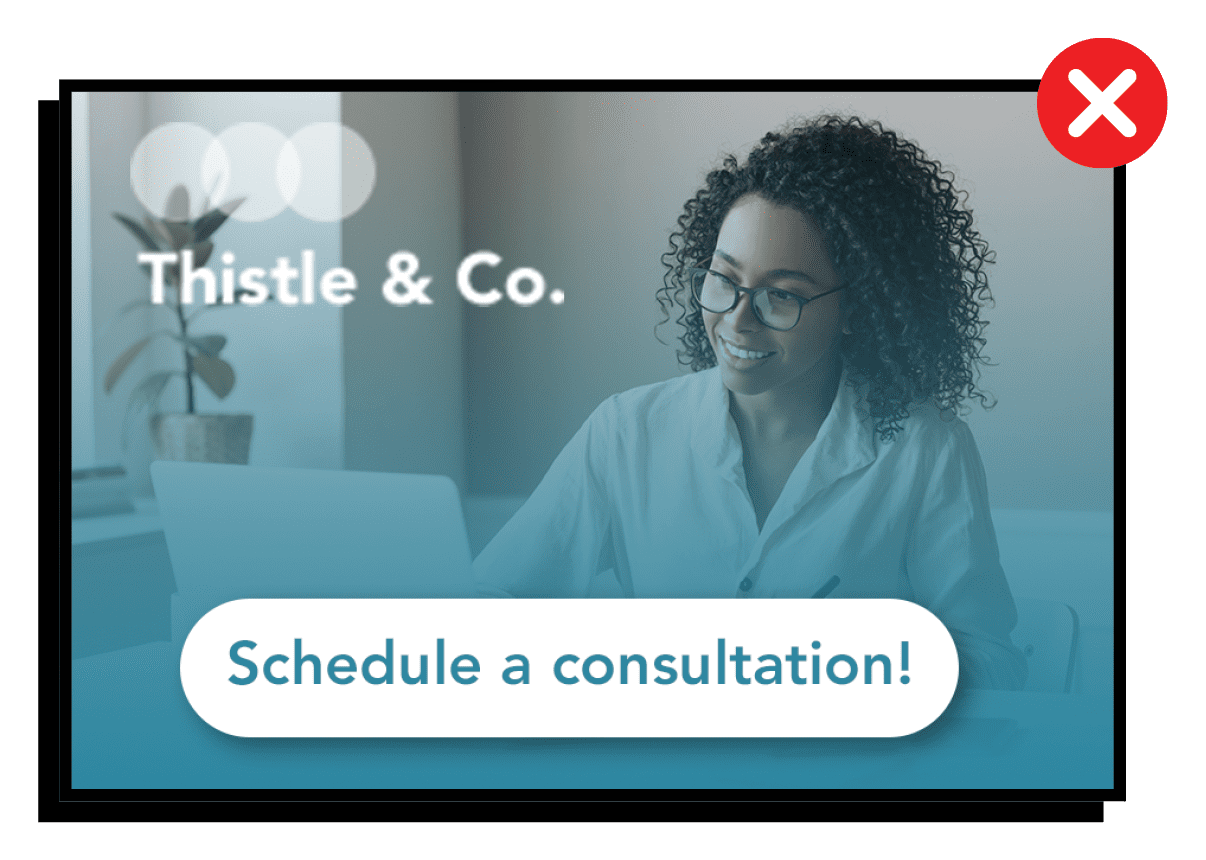
The critical thing about B2B marketing funnels is that you’re serving the right ad to the right people at the right time. Therefore, depending on where they are in the funnel, they’ll see a different ad or a different marketing strategy altogether. While most businesses don’t need to implement all of the varying approaches, it is worth analyzing what method can work best for your business at each key stage: brand awareness, consideration, conversion, and retention & recommendation.
The brand awareness phase is where your business seeks to familiarize itself with the ideal customer. While the perfect customer is likely not ready to convert yet, getting them there means they have to know who you are first. That is what the brand awareness phase is all about. This phase will be the least “salesy” part of your B2B marketing funnel. You want your audience to know who you are without selling to them right away.
Now you may be wondering, “Well, how do I get my audience to know who I am without showing off my amazing services?” It’s a valid question, and as tempting as it is to show off those services, hold off on that until the later stages of the funnel. You can bring them into your audience and directly into your sales funnel by offering an incentive. Incentives can be white papers, downloadable printables, blog posts, articles, data, or several other items. The idea is that your incentives should be catered to your ideal audience.
First things first, you’re going to need to identify who that ideal audience even is.
To have the most effective marketing funnel, you’ll need to be aware of your brand and identify your audience. Ask yourself who your target audience is. Now is the time to build out your customer personas. Using customer personas humanizes your audience. When building your personas, focus on:
Knowing your audiences’ demographics will help you understand where they come from. Once you know this, you can optimize how you target your audience. Examples of demographics are age, gender, and education level. This list is not extensive but a great way to start thinking about your demographics.
Psychographics will let you know where your audience’s interests are. This understanding will help you produce content your customers are more interested in. Some examples of psychographics include interests, personalities, and opinions.
Your audiences’ behavior will tell you their main points and what kind of information they need. When you know what your target audience is looking for, you can produce the types of content they want.
Think about who your personas are and write down some of their characteristics in the chart below:
Demographics
Psychographics
Now that you’ve identified your key audience, let’s look into how you can implement a brand awareness strategy.
Display ads are the banner ads you’ve seen on the internet since the early ’90s. There are many available ad platforms, but most companies run their display ads across Google’s and Microsoft’s ad networks. These ads can appear in blog posts, articles, and pretty much any kind of web page you come across. When setting up display ads, the idea is to bring in as large an audience as possible. Remember that you’ll still be applying demographics to your display ads to get them shown to the most relevant audience possible. You’ll be able to better grasp what demographics to use for your ads after you’ve identified your target audience.
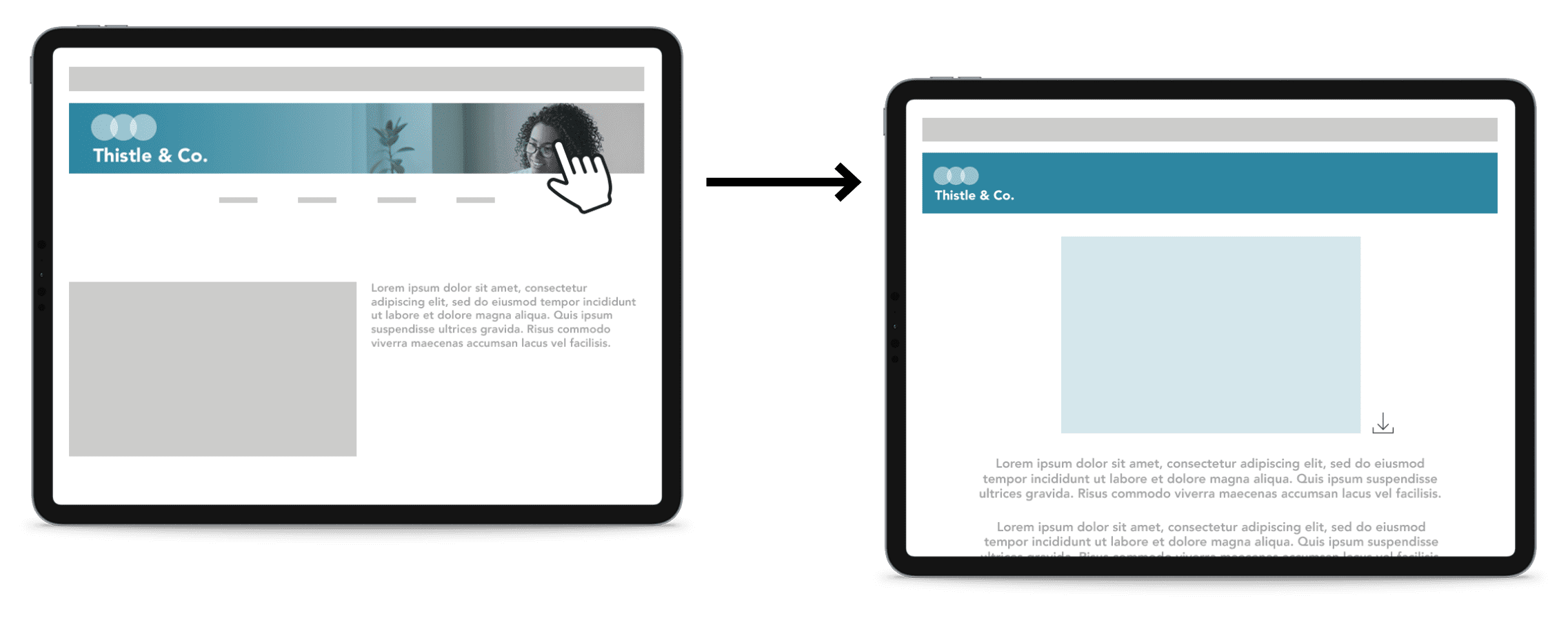
Banner ads typically get charged on either a CPC (cost-per-click) or CPM (cost-per-thousand- impressions) model. How much you get charged is based on several factors, including location, competition, industry, and more. Once users click through, they should be sent to the page where your incentive is. That might be a blog post or a landing page with a download button for your white paper.
Dos & Don’ts
Do utilize graphic design to help your ad stand out from the rest.
Don’t ignore audience and placement targeting when setting up and optimizing your campaigns.
According to Sprout Social, “57% of consumers will follow a brand to learn about new products or services.” Therefore, social media is a vital part of any sales funnel or marketing strategy. As a B2B professional services business, you’ll likely stick with LinkedIn, Facebook, X, and, more recently, Reddit. But, of course, which platforms you use depends on your ideal audience; hence, identifying that audience is crucial.
Consistent and engaging posts on social media let your audience know that your business is still operational and give them an insight into who your business is. With some platforms, their algorithms determine how your audience sees you. Marketers have found that consistent posting is one of the key ways to ensure that your brand is seen in the feed by your audience. However, you want to ensure that you’re posting quality content. Posting unengaging content five times per day is still time-consuming, and it isn’t going to help your social media strategy. Posting unengaging content too frequently can get in the way of your goals. The fewer people who engage with that social media content, the less it’s shown in feed to your audience.
As a general rule of thumb, here’s how often B2B organizations should be posting on each platform:
REMEMBER!
On most of these platforms, you have to engage with other accounts to maximize your strategy. Consider taking time to retweet, share, favorite, repin, like, react, comment, and save other brands’ pages. As a B2B professional service business, building that rapport with your ideal customer can happen by engaging with them on social media.
As social media platforms become more competitive with their ever-changing algorithms, utilizing paid ads on social media is vital for increased reach. You want to focus on prospecting ads at this stage of the funnel. These are similar to display ads but appear on relevant social media networks. Prospecting ads, like display ads, should primarily be utilized to improve brand awareness. In addition, you can use these ads to promote an incentive that you believe to be useful for your audience. Most social media platforms now have detailed and accurate targeting options. Use these to your advantage when setting up ads for the right demographics.
You can target by:
…and more!
Dos & Don’ts
Do try out different media types on social. With the rise of video content, you want to make sure short-form video is included in your creative library. While they take a little longer to create, they generally perform better on most social media platforms.
Don’t set up a personal page for your business. Most platforms now have the option to set up a business page. Having a business page allows you to run ads and better track performance.
As a B2B professional, your personal brand can be as important (if not more so) than your company’s brand. Building up your following will allow you to get a greater awareness for your organization’s content. At this time, the two best platforms for building up a personal brand are X and LinkedIn.
OTT (over-the-top) ads are online advertisements that are optimized for streaming service networks. These ads provide a powerful way to target B2B audiences. They can be highly personalized, and they offer more flexibility in terms of targeting and optimization than traditional digital advertising methods. OTT ads are especially helpful for reaching B2B audiences because they allow for sophisticated segmentation and the ability to precisely target the right customers. This makes them an ideal vehicle for delivering tailored messages and relevant content.
There are a number of streaming services with ad-supported options like Netflix, Hulu, Paramount, ESPN, Disney+ and more.
Dos & Don’ts
Do use programmatic ads’ powerful geotargeting and geofencing capabilities.
Don’t ignore your campaigns once they go live. Just because programmatic campaigns automatically buy and place ads doesn’t mean you can ignore the results.
Below are some ideas of white papers or blog posts you can create for your industry to include in your brand awareness ads.
HR & PAYROLL
CYBER SECURITY & IT
CORPORATE LAW
ARCHITECTURE
At this stage of the B2B marketing funnel, your ideal customer is already familiar with your brand or services and has begun actively seeking you out. Think about yourself and your business as a consumer; when you’re familiar with a brand or its services and are making the decision to purchase, you likely begin to do your research. That’s where your ideal customer is now. They’ve downloaded your white paper, “A Guide to Data Loss Prevention,” and realize that they need data loss prevention, so they begin their research.
You want your business to appear wherever your potential client may be researching your services. Most people will do their research by merely doing a quick Google search. Let’s say you’re a cybersecurity business; your ideal customer may search “how can managed IT services help my business.” At this point, there are two ideal outcomes: your business appearing organically in search or appearing in search ads. Both are viable options, and a mix of the two is generally ideal.
More recently, people have utilized Reddit to research several topics that likely include some or all of your services. According to Reddit, their users average four times more research sessions than other social media platforms. Reddit gets undervalued regarding its ad space; however, the platform has continued to experience significant growth due to its discussion and research-based platform.
Let’s start with how your business can appear organically in search engine results. Your website needs SEO to appear in a search result. SEO is essentially the art of getting your website (or particular web pages) ranking for specific search terms. A strong SEO can attract users in the consideration phase of the B2B marketing funnel. Appearing first for relevant searches can be the difference between receiving a few clicks to hundreds or maybe even thousands of clicks. According to Backlinko, the number one organic search result receives 32% of all clicks, and only 0.8% of searches even went to page two. So getting that number one spot is critical. You’re typically going to rank for search terms by writing a relevant blog post to the search term or updating a web page related to the search term. Google never explicitly states their algorithms for ranking web pages, but marketers have strategies to help you get to that number 1 spot.
The number of words of content you have on your blog post or web page is crucial for ranking highly. If you’re writing about something with no competition, then you may be able to get away with a 500-word blog post. However, your content should ideally be at a minimum of 1,000 words.
Your primary keyword needs to appear throughout your blog post, in headings, and the body of the text. This is because when Google crawls through your page, it wants to see that the blog post is relevant to the users’ search terms.
TIP: Be careful not to overuse your keyword. Over usage is called keyword stuffing, and Google can flag your page, and it can harm your SEO.
Using videos, pictures, animations, and infographics in your blog posts are great ways to improve your SEO. Google wants to see users spending time on your page, indicating that your page isn’t spam. By adding engaging media to your post, you can ensure people spend more time on your page.
Many technical SEO elements, including your meta description, URL, title tags, alt-text, and heading, need SEO optimization. These all need to be updated for your blog post and include your primary keyword.
Thankfully AI machines continue to become smarter and smarter. With just a few simple instructions, AI machines can now spit out hundreds and hundreds of words of SEO optimized text. While AI machines are improving all the time, it’s important to still proofread its text and ensure they work well for SEO purposes. One of the best SEO plugins for your WordPress website is Yoast SEO. It provides you with clear and simple recommendations on how to change your text to better optimize it for search engines. It’s free to download to your site and easy to use!

One of the leading AI tools currently available is Chat GPT. Try it out for your content writing efforts!
Here are some examples of blog posts you may want to write for your industry:
HR & PAYROLL
CYBERSECURITY & IT
CORPORATE LAW
ARCHITECTURE
INSURANCE/FINANCIAL SERVICES
Dos & Don’ts
Do use Yoast SEO to check that your blog posts and content pieces are optimized for search. Yoast SEO has a free version that is more than adequate for your needs.
Do include bullet points and numbered lists. This format will allow readers to review the information quickly.
Don’t forget to do your keyword research. You want to ensure that you’re writing blog posts and content pieces that your ideal customer is looking for.
Don’t create long paragraphs as you will overwhelm your readers.
If you have ever searched for anything, you have come across a search ad. The ads usually appear at the top of the search results page. However, creating an effective ad campaign is often a lot more complex than first meets the eye, and there are several factors to consider.
Search ads work to include as much information about the relevant search term as possible in the ad space. Therefore, there are many elements within a search ad to achieve precisely that.
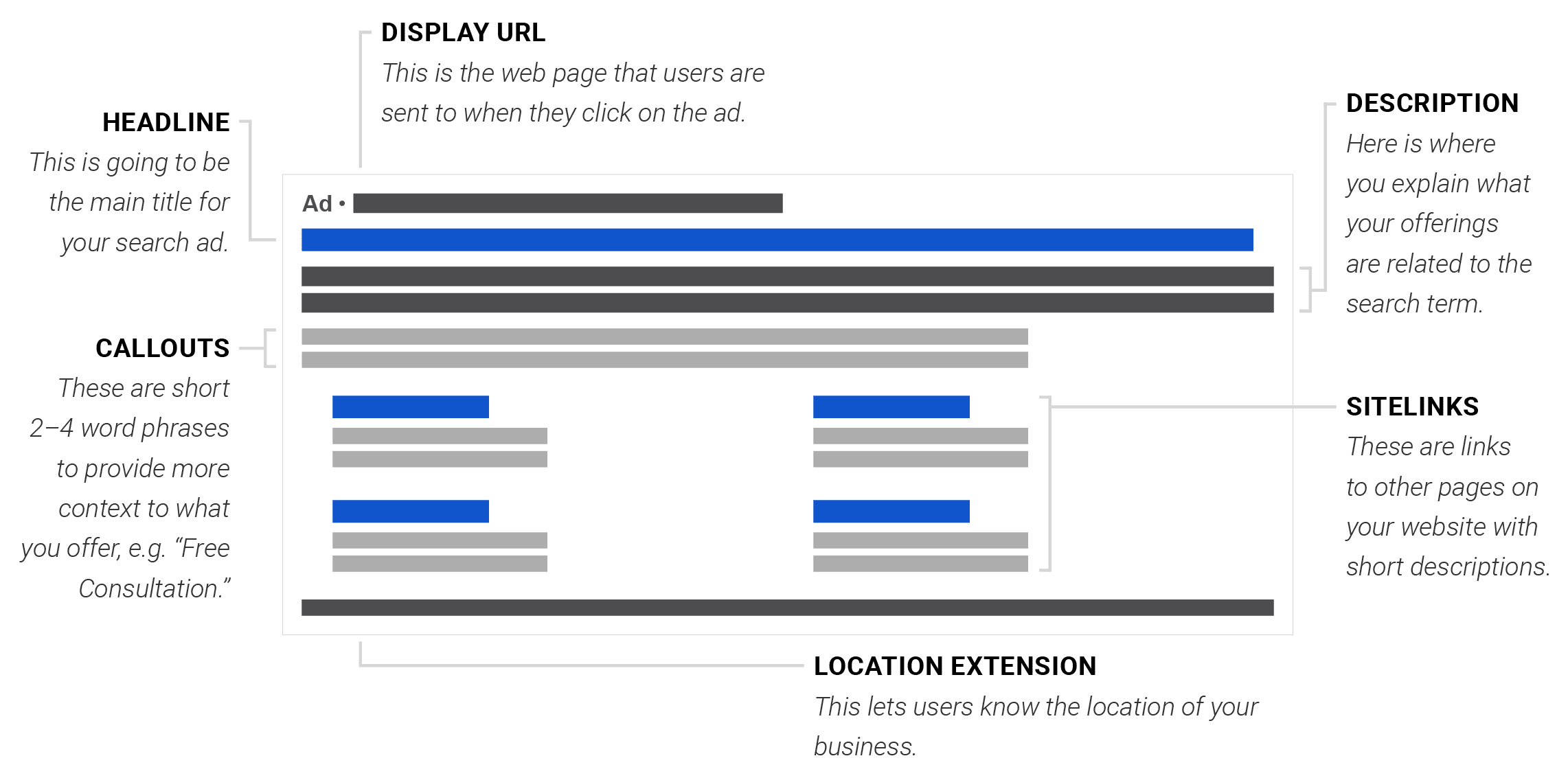
By utilizing as many of these elements as possible in your search ad, you make the ad larger on-screen. On mobile, that ad could consume most of the top of the search page before scrolling. If your ideal customer can get all the information they need about what you offer before scrolling, it makes them more likely to click.
When creating an ad campaign, you need to provide Google with your keyword lists. These lists essentially tell Google that these are the keywords you want to appear for when users search. For example, if you’re a commercial construction company, you may want to add keywords like “local commercial construction company” or “hotel development company.” However, you may find your business appearing for searches that aren’t entirely relevant for your business without a well-thought-out list.
You’re likely not going to be able to think of every single keyword you want to appear for on search because different people search for things in different ways. For example, I may be seeking an IT company to help protect my data. So I could search “data protection for my business” or “business data security company.” While I used very different search terms, I’m essentially seeking the same thing, which is where Google keyword matching comes in handy. You can set different keywords on your list to have a broad match, a phrase match, or an exact match.
Dos & Don’ts
Do include terms from your keyword list in your ad’s headline and description copy.
Don’t forget to use extensions across all your campaigns, ad groups, and ads.
Below you can see examples of different search ads for various industries:
HR & PAYROLL
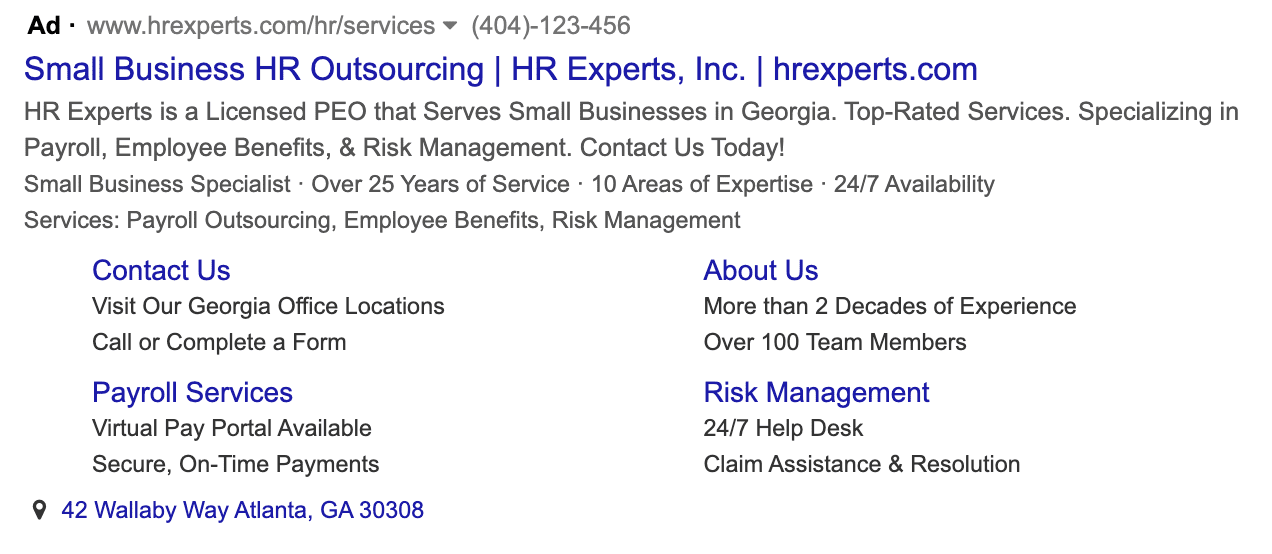
CYBER SECURITY & IT
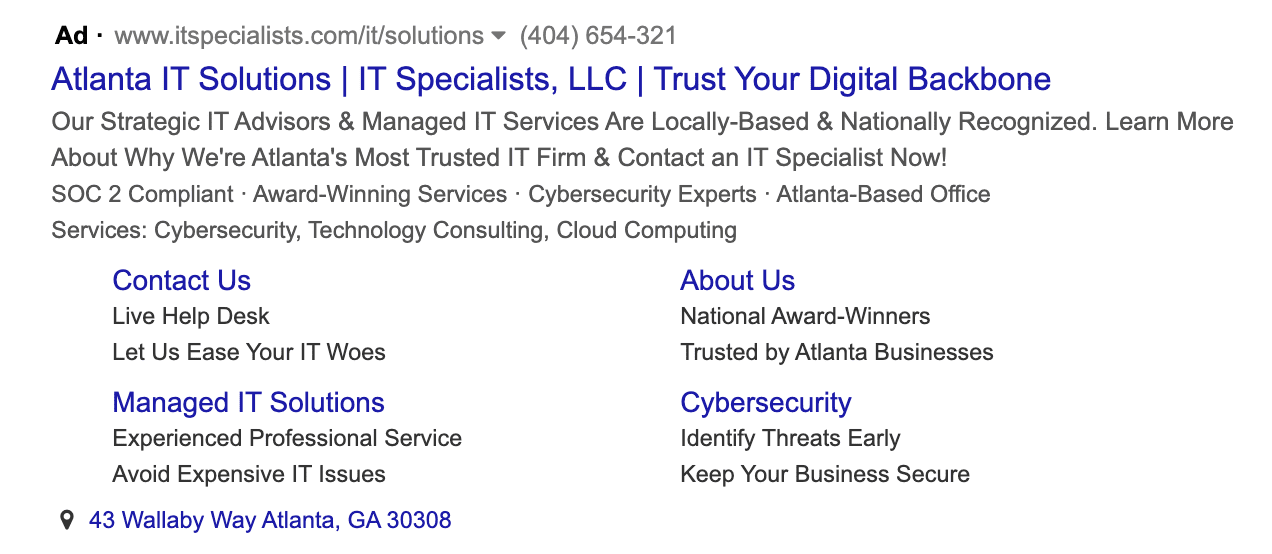
CORPORATE LAW
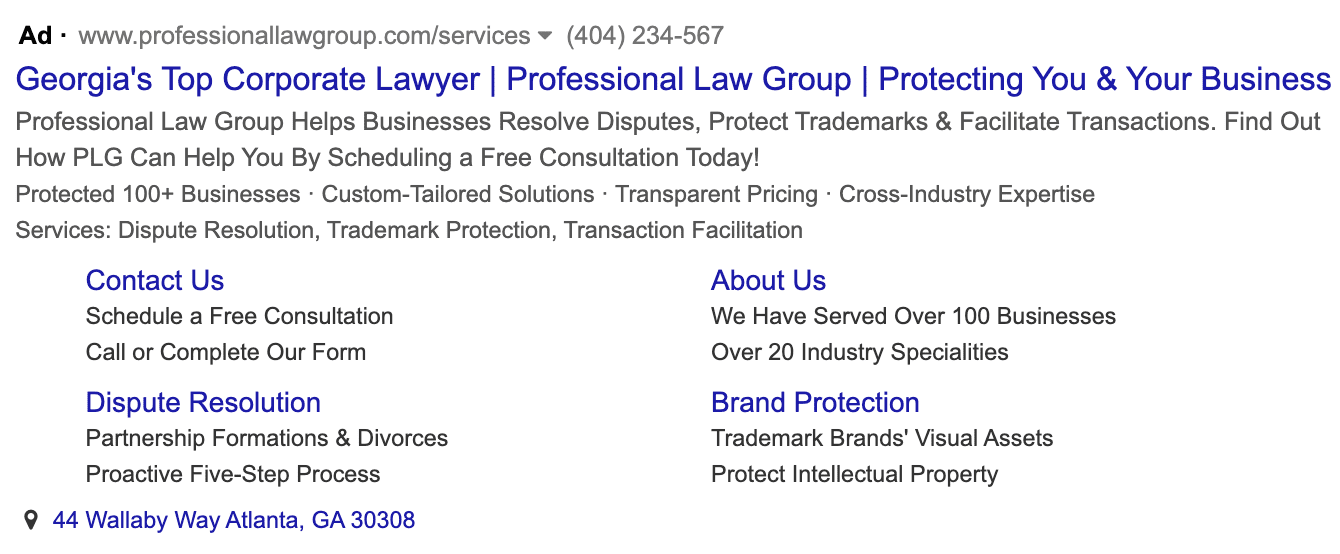
CONSTRUCTION
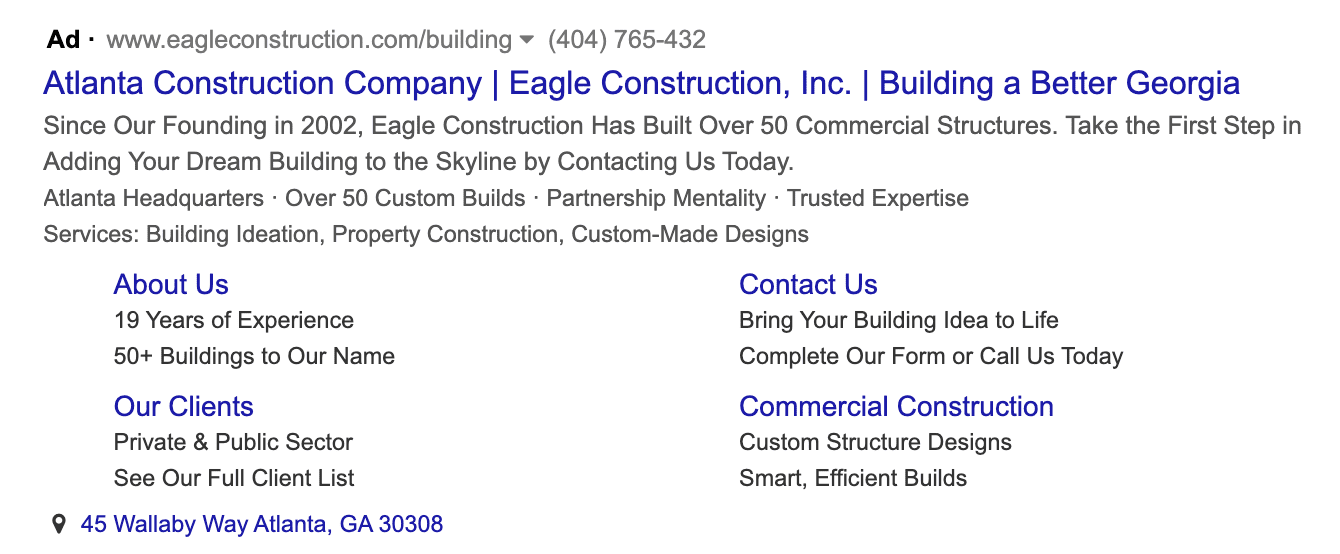
This phase will be the most crucial stage of your B2B marketing funnel. After getting your audience familiar with your products and services, it’s time for them to convert. Depending on what your business is, that conversion can look very different. Perhaps they buy an HR course or schedule a consultation with your IT experts. Whatever that conversion action looks like, it happens at this stage.
You can implement Google Remarketing on Google Search or Google’s Display network. If you’ve set up all your conversions correctly, you’ll be able to serve remarketing ads to users who have visited your website. By opting for a full B2B marketing funnel solution, your ideal customer has likely already seen your site via an engaging blog post, clicking on a display ad, or clicking through to your website from social media.
The primary differentiator of a remarketing ad is that it has an explicit call-to-action enticing your ideal customer to click through and convert. In the higher stages of the funnel, your main goal is to provide something valuable to your audience to understand your business or services better. Now your primary goal is to purchase these users.
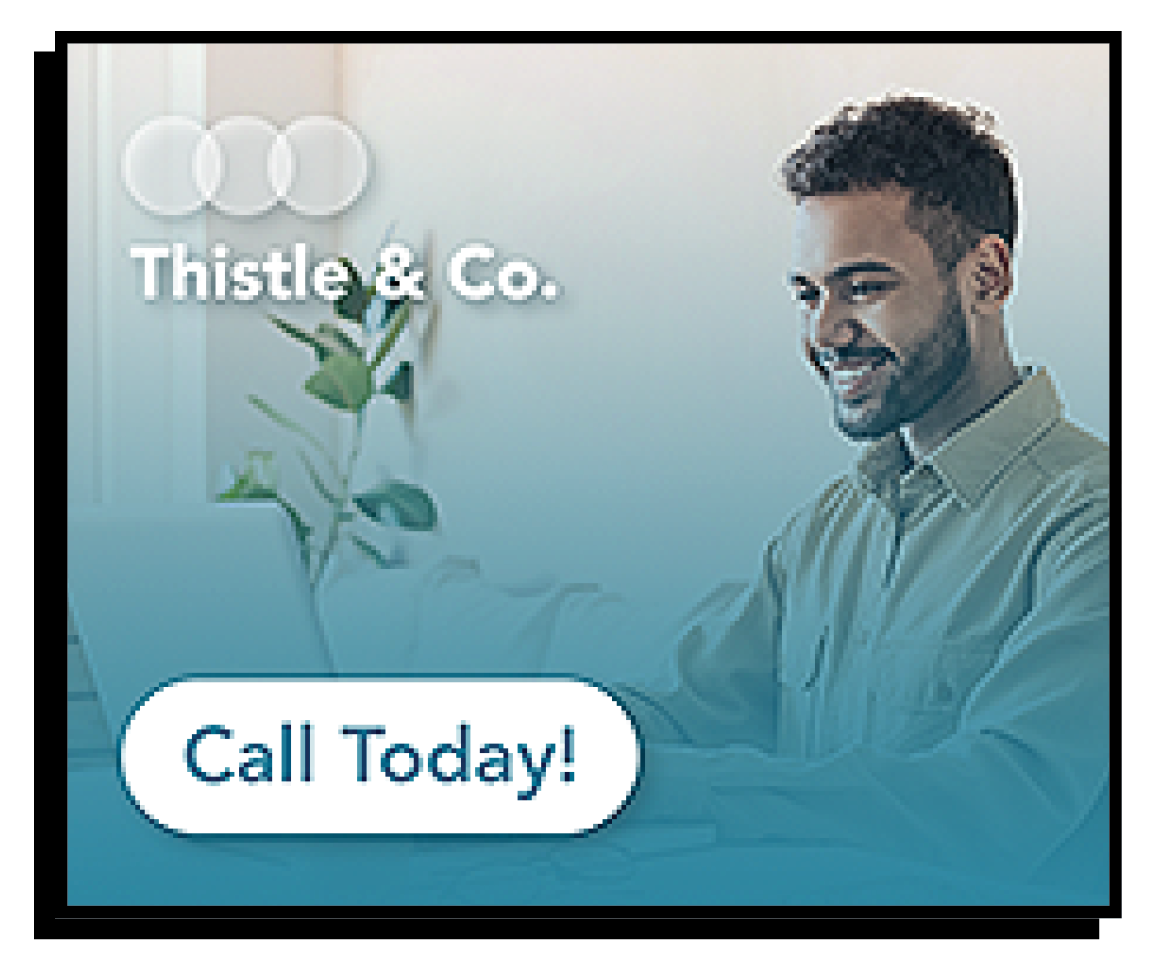
Dos & Don’ts
Do create specific audience lists you want to remarket to based on distinct consumer interactions with your brand.
Don’t build out remarketing campaigns before an audience has populated.
Social media remarketing works similarly to Google remarketing. Users in your B2B marketing funnel who have interacted with your website can be served social media remarketing ads on their respective platforms. Again, these ads will need a prominent call to action to entice the user to click through and convert.
The powerful thing about social media ads is that you get to remarket to your audience on platforms you know they’re likely to be on consistently. Think about how you spend your time on the internet. Perhaps you spend a little time online shopping; maybe you read an article. What’s the one platform that you likely come back to daily? Social media. People in the U.S. spend an average of 2 and a half hours per day on social media. If you take out 8 hours for sleep and 8 hours for work, that’s a quarter of your free time!
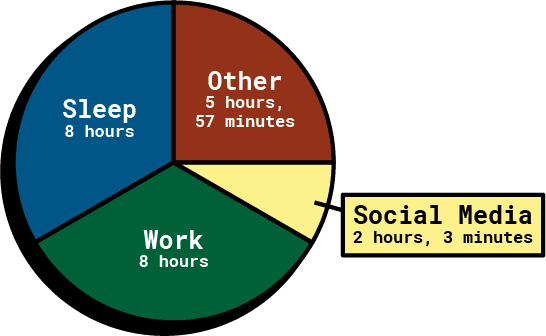
Dos & Don’ts
Do A/B test your ads so you can test which ad resonates best with your audience.
Don’t expect your remarketing audience to populate overnight if this is your first digital marketing strategy. It may take a while for your audience to populate to the correct size.
A conversion-heavy landing page is key to converting users who click through. When you click on an ad, you don’t want to search for the necessary download button or contact form to convert. The searching will often lead users to leave the site. Instead, make it easy for your customer to convert. Ask as few details as possible while providing the easiest route to conversion possible.
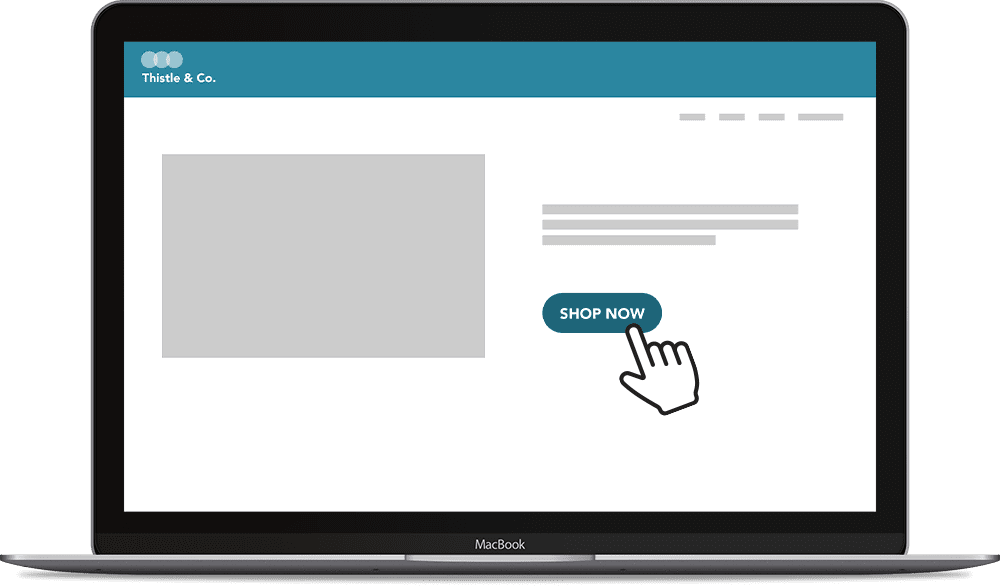
I run an HR company that sells multiple online courses to help businesses manage their HR better. I have a shop page on my website with all of the various classes. When a user clicks on an ad to purchase HR diversity training courses, they shouldn’t go to the general “Shop” page; they should go to a specific landing page for HR diversity training courses. The landing page could consist of one holistic course or even a bundle of lessons on the same topic with an easy “buy now” call-to-action.
The highest B2B average conversion rate by industry is professional/ financial services at 10%.
Dos & Don’ts
Do use your analytics to see how users are interacting with your landing page and adapt accordingly.
Don’t lead the user to an irrelevant page or add roadblocks to their conversion.
Okay, so you’ve implemented multiple stages of this B2B marketing funnel, and your leads are growing, but now you can’t keep up. That’s usually a good problem to have; however, it can work against you if you don’t keep on top of your leads. Chatbots are becoming more and more essential as part of a growing marketing strategy. Chatbots help filter your customers so you can respond to the ones that need your attention the most.
Let’s look at this chatbot below. With just the first question, you can determine what the person needs.
Dos & Don’ts
Do utilize chatbots to qualify who is in the conversion phase.
Don’t overuse bots. People know when they are speaking to a bot and are usually less engaged. Try to keep questions or answers from a bot to a maximum of 3 before passing the customer to a representative.
Did you know that according to research done by Frederick Reichheld of Bain & Company, a 5% increase in customer retention rates can increase profits by 25% to 95%? Retaining your existing customers is a lot more cost-effective than attaining new ones, so don’t forget the power in your existing customer base in your B2B marketing funnel. Perhaps you could offer an incentive if they provide a great testimonial or case study. Those testimonials and case studies work well in re-marketing ads by providing social proof that your services are effective.
Now that we know what strategies to use for each stage of the B2B marketing funnel, we need to set up tracking. Tracking is critical for any marketing strategy. It allows you to assess what is working and what is not so you can adapt accordingly. As a B2B professional service business, three main tracking tools are a must-have for any marketing campaign.
Whether you run a marketing campaign or not, Google Analytics is a vital tool to install on your website. It will help you discern where your audience is in the B2B marketing funnel stages. It can tell you how many users come to the site, how much time they spend on it, and what pages they view the most (among countless other data points). Setting up analytics is essential to find out which strategy is working best. For example, you may find that your LinkedIn ads are doing great, but your Google display ads aren’t. Based on this information, you can pivot your campaign to spend time and money in areas that are performing the best.
For more information on Google Analytics, check out our Google Ads & Analytics guide!
Facebook Pixel is key to tracking your audience from Facebook and beyond. Install Facebook Pixel on your website to get all the tracking information about your Facebook & Instagram traffic as well as ad performance.
For more information on advertising with Facebook, read this blog post.
As a B2B professional service business, you cannot automate most of your conversions. For example, when someone decides to purchase, they likely have to speak to a sales team. That sales team needs to be using a CRM to keep track of all of those leads. A sales CRM ensures that none of your leads slips through the cracks. With Hubspot CRM, you can utilize several tools to keep organized, like deals, tasks, and email templates.
Read more about why you need a sales CRM in this blog post.
Below are some of the many tools that can help you build a robust marketing strategy with an effective B2B marketing funnel.
This handbook has lots of information, and it will be overwhelming for an individual to tackle it all at once. We recommend picking out three things from this guide that you want to build on this week and approaching them one at a time. The great thing about B2B marketing funnels is that a small optimization will lead to significant results down the line—so get to work!